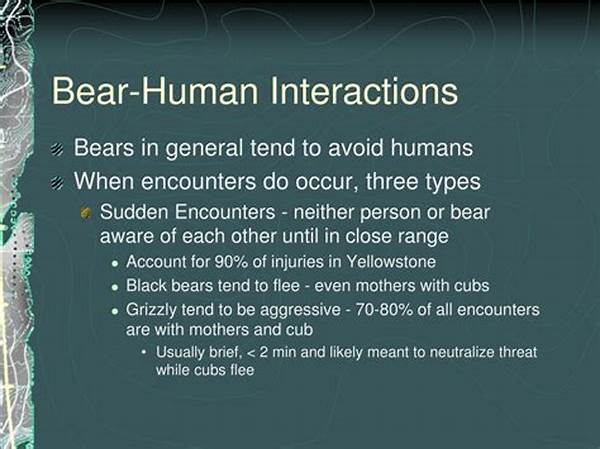Coming face to face with a bear might sound like an adventure from a thrilling novel, but in reality, it’s crucial to be prepared for such encounters. Whether you’re hiking in the wilderness or living near bear habitats, understanding how to safely interact with these magnificent creatures is essential. In this article, we’ll delve into some key guidelines for bear human interactions to ensure both you and the bears stay safe.
Read Now : Reducing Dust Risks To Bear Populations
Understanding Bear Behavior
Bears are fascinating creatures with behaviors that can sometimes seem puzzling to us. To put it simply, if you’re gonna hang out in bear country, you better know the basics, dude. Bears are typically shy and not looking to pick a fight. However, they can become aggressive if they feel threatened or surprised. The golden rule among the guidelines for bear human interactions is to give them space and respect. Keeping a safe distance and not sneaking or creeping up onto a bear are top priorities. When you see a bear, stay calm, dude! Back away slowly, and never turn your back or run. Remember, it’s all about keeping the vibe chill between you and the bear. Also, keep the food stashed and scents minimized in wild territory; bears have a nose that can sniff out a juicy snack from miles away. So, don’t be a bad neighbor in bear-land!
Bear Protocols for Outdoor Enthusiasts
1. Keep Your Distance: Bears need personal space, bro. Don’t get all up in their grill; stay at least 100 yards away to avoid drama.
2. Make Noise: Chat or sing while hiking. This helps in announcing your presence, so you don’t startle your furry friends on the trail.
3. Store Food Properly: Lock up munchies in bear-proof containers. Don’t invite bears to a snack fest at your campsite!
4. Stay Calm: If you spot a bear, channel that inner zen. Panic is no bueno; just breathe and back away slowly.
5. Travel in Groups: Roll with your squad. Bears are less likely to approach a posse, so gather your crew for safety.
Safety Measures for Campers
When camping where bears roam, certain guidelines for bear human interactions are non-negotiable. First, always store food and scented items like toiletries in bear-proof containers, either hung high or stored in lockers provided at campsites. Bears have a keen sense of smell and associating humans with food leads to increased bear interactions and potential dangers. Next, keep your campsite spick and span. No leftovers, yo! Trash should be sealed and stored away properly to keep bears from wandering through looking for a midnight snack.
The guidelines for bear human interactions also highlight making noise. While it may sound counter-intuitive, being loud lets bears know humans are around, reducing surprise encounters. Clap and chat while on the move, and carry noisemakers like bear bells. These simple actions could very well keep you and Yogi from a face-to-face. It’s also crucial to avoid hiking alone during bear season. A crew not only makes noise but is also intimidating to solitary bears. Plus, group size diminishes risk if things go sideways.
Read Now : Bear Selection For Novices
Common Myths about Bears
There are countless misconceptions about bears, often fueled by folklore and pop culture. Some folks think playing dead is a universal trick, while others imagine that all bears are dangerous. However, understanding the guidelines for bear human interactions is vital. For instance, playing dead only works in certain situations, like when facing a grizzly bear – not with black bears, who might see you as lunch. Not cool, bro.
Other myths involve climbing trees to escape. Sure, some bears aren’t avid climbers, but many can shimmy up there faster than you’d think. Knowing how to behave during a bear encounter trumps outdated survival tales any day. So, arm yourself with knowledge, not myths, and you won’t end up in a hairy situation. The guidelines for bear human interactions are here to steer you clear of bear-ly believable tales and into fact-based safety protocols.
Bear Encounters: Real Talk
Okay, let’s dive deep here. Rolling up on a bear unprepared is like showing up to a party with no invite—trouble’s bound to find you. Bears, especially grizzlies, have this knack for popping up when you least expect it. And if you’re not equipped with the guidelines for bear human interactions, man, you’re in for a wild time.
Now, you’d think most bears are just itching for a fight, but nah, they’re more into a lazy day vibe. They got their own business to handle, you know? That’s where the guidelines for bear human interactions come into play. A little prep can transform a potentially gnarly situation into a mellow encounter. The key? Noise. Bears are like, if I can hear ya, I can avoid ya. So, crank up the decibels when you’re out there.
Why Guidelines Matter
Listen up—these rules aren’t just words on a page, they’re lifelines. Bears, while majestic, pack a punch if they’re freaked out, and that’s why sticking to guidelines for bear human interactions is a no-brainer. Respect and caution, dude, are your best allies. Brush up on the deets and keep it safe out there. Every bear has its own vibe, so be ready for anything. Keep it real, follow the rules, and you’ll be swapping bear tales instead of horror stories over the campfire.

